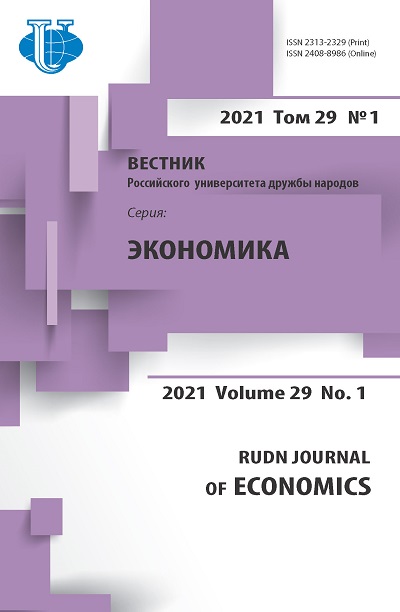Methodological aspects of evaluating a company’s investment attractiveness
- Authors: Nemtseva Y.V.1, Vorozhbickaya Y.V.1
-
Affiliations:
- Novosibirsk State University of Economics and Management
- Issue: Vol 29, No 1 (2021)
- Pages: 114-125
- Section: ECONOMIC GROWTH AND SOCIO-ECONOMIC DEVELOPMENT
- URL: https://journals.rudn.ru/economics/article/view/26018
- DOI: https://doi.org/10.22363/2313-2329-2021-29-1-114-125
Cite item
Full Text
Abstract
The actual problems of choosing tools for risk assessment and predicted profitability (attractiveness) of an investment object are studied. There is a close relationship between the financial multipliers DIV/FCF, P/E Shiller, EV/EBITDA and risk indicators, which gives the investor the opportunity to make additional operational forecasts when analyzing an investment project. A number of key financial multipliers (P/S, EV/S, P/OCF, P/FCF) have been identified, and it is not entirely correct to use them as criteria for making an investment decision. The expediency of using the EV/EBITDA multiplier for making forecasts about the volatility of the return on shares of a certain company is justified, since this is the only indicator among the financial multipliers selected for analysis that has a relationship with the beta coefficient. Recommendations for forming a sample of necessary indicators (multipliers) when making investment decisions by various stakeholders are proposed.
About the authors
Yulia V. Nemtseva
Novosibirsk State University of Economics and Management
Author for correspondence.
Email: nemtseva_july@mail.ru
PhD in Economics, Docent of the Department of Corporative Management and Finance
56 Kamenskaya St, Novosibirsk, 630099, Russian FederationYulia V. Vorozhbickaya
Novosibirsk State University of Economics and Management
Email: vorozhbickaya@yandex.ru
2nd-year master’s student of the Department of Corporative Management and Finance
56 Kamenskaya St, Novosibirsk, 630099, Russian FederationReferences
- Alekseev, M.A., Savelyeva, M.Yu., & Slaykovskiy, S.A. (2017). Vliyanie manipulirovaniya finansovoy otchetnost'yu na otsenku stoimosti kompanii [The impact of manipulating financial statements on the company's valuation]. Siberian Financial School, (5), 107–110.
- Becker, A.V., Vorozhbitskaya, Yu.V., & Shipunova, E.D. (2016). Vzaimosvyaz' razlichnykh vidov pribyli i riskov v teorii rychagov [The relationship of various types of profit and risks in the theory of leverage]. Humanization of Modern Science: Research, Innovation, Education: Materials of the XII All-Russian Scientific and Practical Conference (Ufa, April 12, 2016) (pp. 219– 225). Ufa: Aeterna Publ.
- Busov, V.I., Zemlyanskiy, O.A., & Polyakov, A.P. (2013). Otsenka stoimosti predpriyatiya (biznesa) [Valuation of an enterprise (business)]. Moscow, Yurayt Publ.
- Chechin, V.V. (2017). Investitsionnye predpochteniya chastnykh investorov kak osnova prinyatiya resheniya na rynke tsennykh bumag [Investment preferences of private investors as the basis for decision-making on the securities market] (Abstract of the Dissertation of the Candidate of Economic Sciences). Novosibirsk.
- Chirkova, E.V. (2017). Kak otsenit' biznes po analogii: Metodologicheskoe posobie po ispol'zovaniyu sravnitel'nykh rynochnykh koeffitsientov pri otsenke biznesa i tsennykh bumag [How to evaluate a business by analogy: A methodological guide to the use of comparative market coefficients in evaluating businesses and securities]. Moscow, Al'pina Biznes Buks Publ.
- Ferulev, N.V., & Shtefan, M.A. (2016). Vyyavlenie faktov fal'sifikatsii finansovoy otchetnosti v rossiyskikh kompaniyakh: Analiz primenimosti modeley Benisha i Roksas [Identification of falsification of financial statements in Russian companies: Analysis of the applicability of the Benisha and Roxas models]. Russian Management Journal, (3), 49–70.
- Ionin, V.G., & Nikolaeva, N.Yu. (2017). Analiz struktury riskov kompanii na osnove pokazateley effektov rychagov [Analysis of the company's risk structure based on leverage effects indicators]. Vestnik NSUEM, (2), 274–292.
- Kogdenko, V.G. (2008). Metodika analiza effekta sopryazhennogo rychaga po dannym finansovoy otchetnosti [Methodology for analyzing the effect of the conjugate lever based on financial statements]. Audit and Financial Analysis, (3), 44–52.
- Kosorukova, I.V., Sekcheva, S.A., & Shuklina, M.A. (2015). Otsenka stoimosti tsennykh bumag i biznesa [Valuation of securities and businesses]. Moscow, Moscow Academy of Finance and Industry.
- Lyuts, E.V. (2020). Metodicheskiy podkhod k regulirovaniyu doveritel'nogo upravleniya na rynke tsennykh bumag Rossiyskoy Federatsii [Methodological approach to the regulation of trust management in the securities market of the Russian Federation] (Abstract of the Dissertation of the Candidate of Economic Sciences). Novosibirsk.
- Pavlyuk, A.O. (2017). Sravnitel'nye kharakteristiki iskazheniya bukhgalterskoy otchetnost'yu v kompaniyakh [Comparative characteristics of distortion of the accounting reporting in companies]. Economics, Management and Law: Innovative Problem Solving: A Collection of Articles by the Winners of the VIII International Scientific and Practical Conference (Penza, May 25, 2017) (pp. 138–141). Penza, Nauka i prosveshchenie Publ.
- Shapkin, A.S., & Shapkin, V.A. (2013). E'konomicheskie i finansovye riski: Otsenka, upravlenie, portfel' investitsiy [Economic and financial risks: Assessment, management, investment portfolio]. Moscow, Dashkov i K Publ.
- Walsh, K. (2001). Klyuchevye pokazateli menedzhmenta: Kak analizirovat', sravnivat' i kontrolirovat' dannye, opredelyayushchie stoimost' kompanii [Key management indicators: How to analyze, compare and control the data that determine the value of the company]. Moscow, Delo Publ.















